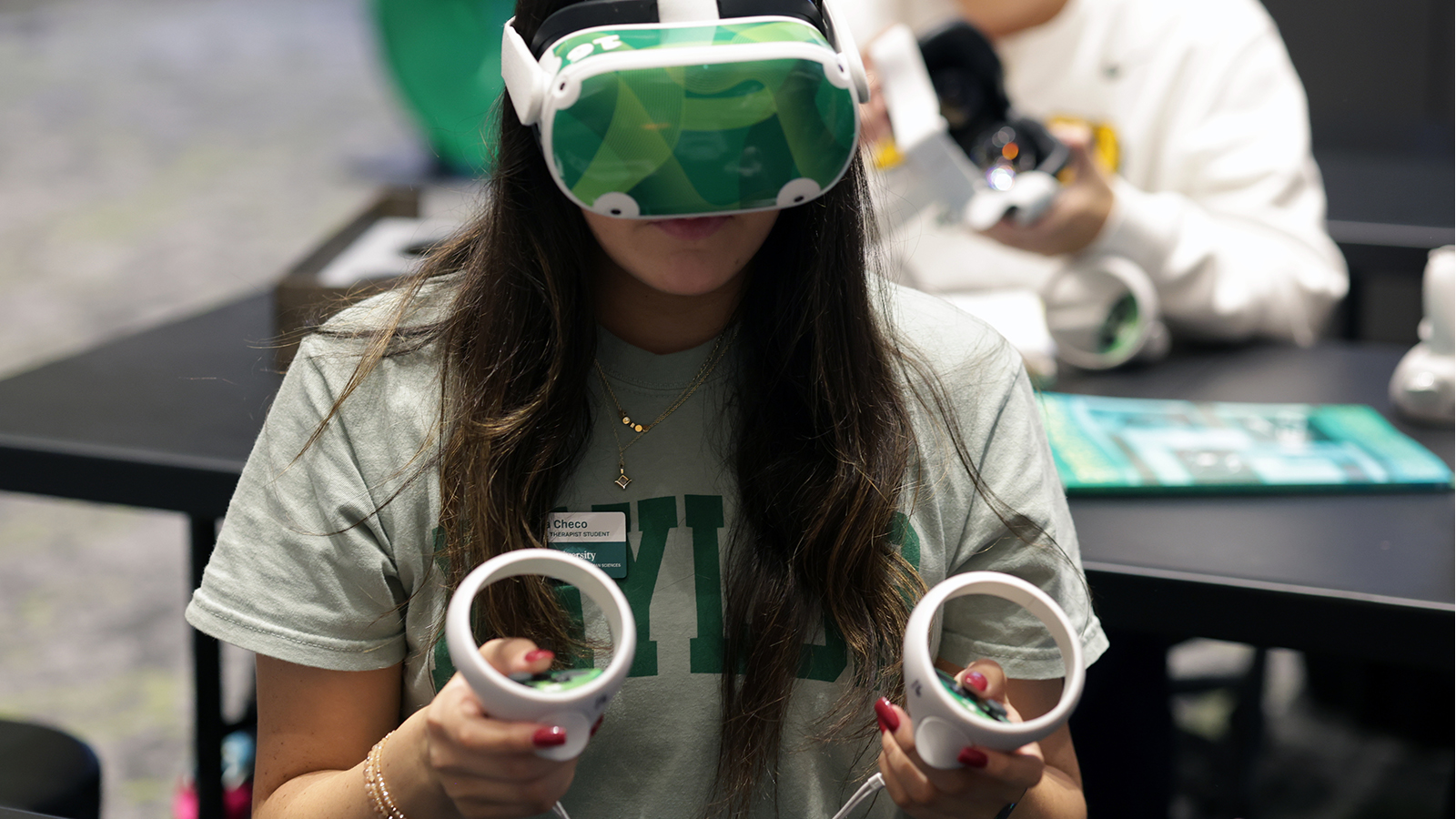Dynamic Learning Through Virtual Reality
The Department of Occupational Therapy utilizes virtual reality technology as an education tool, integrated within three courses. Students virtually engage patients at a hospital, during a home assessment, and in a community setting.

Imagine walking into a hospital room, looking toward your patient’s bed, and noticing all the wires, tubes, leads, and machines around them. Now, imagine you are just three weeks into your OT student journey. You introduce yourself and start to converse with your patient who is feeling short of breath and dizzy. Based on the conversation, you discern the possible problem, order the appropriate vitals to test, and determine the best way to safely continue with therapy.
After finishing the conversation, you remove your Oculus virtual reality (VR) glasses and debrief with your fellow Baylor University Doctor of Occupational Therapy (OTD) students. This is the newest Baylor OTD lab experience, designed to enhance learning outcomes through an immersive and interactive environment.
“An acute care setting is not something we would typically get our students into during their first term, and these students are only three weeks into the program, experiencing a very realistic acute care experience from the safety of the classroom,” said Clinical Associate Professor Kayla Collins, EdD, OTR. “It gets our students to start using clinical reasoning skills early in the program and in a contextualized experience. The scenarios put a little more pressure on the students to apply the material in novel situations.”
Knowing the benefits of VR, along with the support of Baylor’s investment in headset equipment, Collins advocated to integrate this educational material into the hybrid curriculum.
“We can fit a lot of learning–very dynamic learning–into a short period of time, and there’s a lot of cognitive, affective, and psychomotor learning going on, so it's very contextualized,” Collins said. “Our students can move through a scenario in 15 minutes and have this really rich learning experience, one that might have taken us hours to do outside of the virtual reality. We have an accelerated program, so we must use our time efficiently. Virtual reality helps us create more efficient learning experiences that are just as rich and deep—if not deeper—than what we can do with other types of activities.”
The creation of scripts and videos has been a collaborative effort across Baylor’s campus. Collins partnered with Interactive Learning Experience Developers, from the Learning Design team at Moody Memorial Library, for this endeavor. Collins was responsible for developing the scripts, ensuring both fidelity and accuracy of the clinical content. Utilizing these scripts, the Learning Design team collaborated with faculty from the Department of Theatre Arts, who contributed their acting skills, to film the scenarios. Following the filming, the Learning Design team took charge of editing the videos and transformed them into an immersive VR experience.
“As one of the only OT programs using this type of virtual reality to enhance the curriculum, we hope it showcases the evergreen and innovative nature of our program,” said Department Chair Marian Gillard, PhD, OTR/L, FAOTA. “Virtual reality allows us to deliver unique and emerging practical experiences to our students. This technology not only allows us to adapt to the changing demands of healthcare education but also equips our students with firsthand knowledge to employ virtual reality when developing innovative interventions.”
Currently, VR is integrated within three occupational therapy courses, which students experience during the intensive lab immersion experiences that occur in Waco approximately every six weeks during their first year of the program. Amber Lupo, a current Entry-level OTD student, enjoyed engaging with virtual patients in common OT settings such as a hospital, a home, and a community.
“VR has enhanced my learning by allowing me to go through a real-life simulation and use my OT skills to determine the best plan of care for patients,” Lupo said. “It allowed me to see many different settings and work through challenges to discover the best path. For example, my favorite thing about the VR lab activity was being able to ask the patient questions, get 'real' answers that an actual patient would say, and then adapt my responses to that. It allows for a glimpse into what the Fieldwork and Capstone experiences will be like in year two.”
Virtual reality is an effective tool in the classroom. When integrated with traditional teaching methods, it holds the potential to enhance theoretical knowledge, refine practical proficiencies, and elevate overall learning satisfaction.
“I hope that the students walk away feeling more confident—after all, that really is the goal of exposing them to multiple clinical scenarios before they go to Fieldwork,” Collins said. “What we want is for them to feel more competent, not just in their clinical skills, but in being able to perform under pressure, being able to perform under supervision, and in novel situations. I want students to remember this experience, to have an emotional connection to learning.”
Faculty believe this dynamic learning process compliments the Department’s curriculum and mission. Baylor students will continue to gain the benefits of VR experiences beyond lab immersions, as the Department intends to build upon the cutting-edge technology by developing additional scenarios.
“We are not just reimagining education delivery through our hybrid format,” Gillard said. “We are revolutionizing it by offering transformative learning experiences that cultivate exploration, adaptation, and clinical reasoning.”